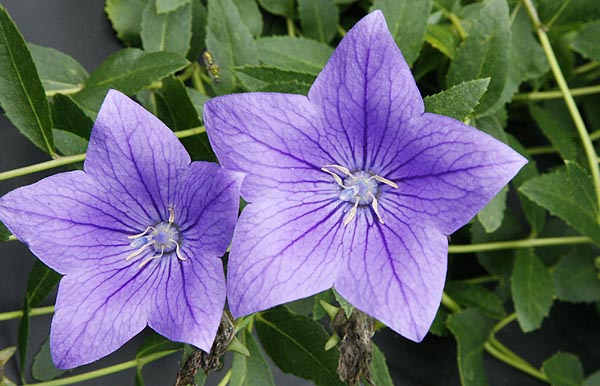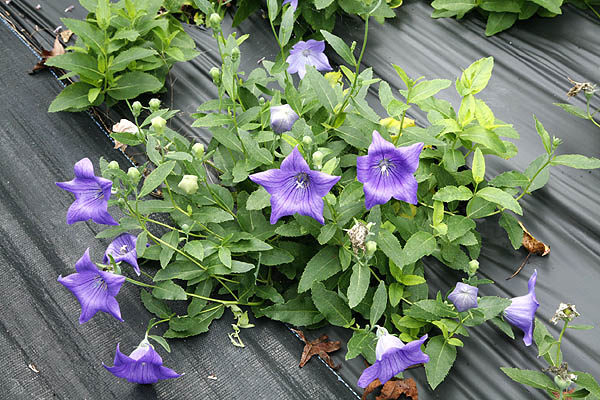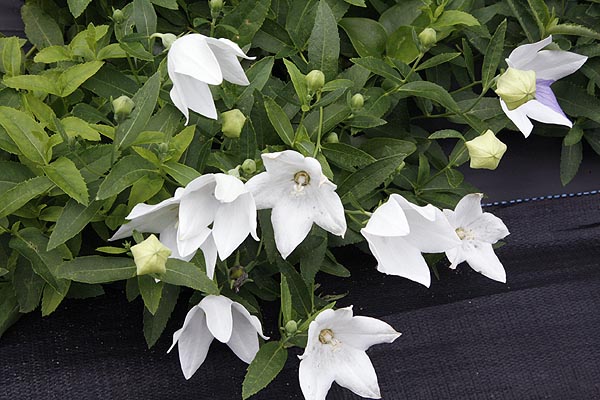Easy to grow perennial hardy to zone 3 with lovely sky blue star shaped flowers that bloom throughout the summer months. Known as balloon flower because the flowers begin life as a large balloon like globule that suddenly burst open to display the flower. It's hard to pass by the plant without popping open at least one of the blooms and children delight in this activity. Very easy to grow, will flower from seed the first year, often short and prostate for the first year or so before the large tap root is strong enough to produce tall upright plants reaching up to 4 feet (1.2m) in height. Due to tap root does not like to be moved once established but will come back year after year with no care, just cut down the stalks once a year so it's ideal for any flower garden or meadow setting in a 'mow it down' garden. Likes full sun to part shade and well drained soil.
Each flower is short lived but they appear in such profusion that flowering goes on for over a month sometimes more. Flowers are followed by small star shaped seed pods that open at one end like small vases and are much loved by small rodents.
In colder zones plants die back in winter but may stay green in zones warmer than 7b.
Keep warm and moist with a good light source until germinated and seedlings are large enough to transfer to larger pots. Make sure the roots are not damaged. Platicodons are very sensitive about their roots and damage can stunt growth.
Once plants are large enough and have been hardened off they can be transplanted to the garden: again ensure that the roots are not disturbed and choose your location carefully as they don't take well to transplanting.
While some sources suggest that stratification is required all our seeds are kept in cold conditions and we have not found extra stratification necessary to achieve good germination rates.
Soil. It does seem to prefer a slightly acidic soil rather than strongly alkaline. Soil can be locally modified by adding coffee grinds or finely chopped pine needles in small quantities to the soil around each plant. Do not add mounds of these ingredients as this can burn the plants and the soil. Otherwise will grow in most kinds of soil provided it is not continuously wet. Likes a well drained soil and does quite well in sandy soils. However best results are achieved if the soil has a good amount of organic material in it. Recommended that this should be added before transplanting. Create a mix that has about 45% organic material at planting time. These are perennials and there will not be another chance to add material to the soil once they are in place so this has to last them a lifetime. Small amounts can be top dressed after the plants are established if desired.
Light. Plants in zones 3-5b do well in full sunshine all year. From 6a to 7b can tolerate some partial shade with some shade and some full sun throughout the day. Below 7b light shade is best with good shading from noon sun, an area that gets morning or afternoon sun is ideal but it can tolerate north facing areas provided light is good, does not do well in full shade.
Water. Plants develop a large strong tap root and do not like to be moved once they are established so choose your location carefully. Once the tap root has developed the plants are fairly drought resistant but if drought is prolonged and regular the plants may wane over time without added water as it will shrink the tap root. They certainly do better if they have some regular watering becoming much stronger and larger. An ideal watering would be to run a soaker hose around the base of the plants and water at least 3 times a week depending on the amount of rainfall, location and soil drainage.
Will most commonly flower the first season from seed but plants are usually smaller often prostrate as they are beginning to develop their tap roots. In poorer locations or inadequate soil or light plant may remain prostrate for several years. If location is acceptable they grow much taller and produce small clumps of flowering stalks. If your plants remain prostrate you may consider carefully moving a few to a different location to see if this improves their form.
Once established with a good tap root these lovely flowers take little care and only need cutting down once a year. Ensure you know where they are located as they are much slower to produce spring shoots than other plants and can sometimes be forgotten and either dug out or planted over accidentally. Works well in meadow like settings mixed with other perennials and mown down once a year.
While some sources state that the leaves can also be used only the young leaves at the top of the stem should be harvested since they produce toxic substances as they mature.
Young top leaves can be added to salads, where they give a satisfying crunch. The older leaves are sometimes collected dried and used as flavouring in Asian countries.
Which name is correct Platycodon grandiflorus or Platycodon grandiflorum?
These two names seem to be used interchangeabley for the same plant. The actual botanical name is Platycodon grandiflorus. However in Asian medical texts especially those from Korea where the root is known as Doraji it is attributed to Platycodon grandiflorum it is unclear whether this was originally a mistake that has been reproduced everywhere or if this is the accepted name in Korea. Whatever the origin the different names are proliferated depending on where the new author obtained their source material and what they are discussing. In other words it's darn confusing.








